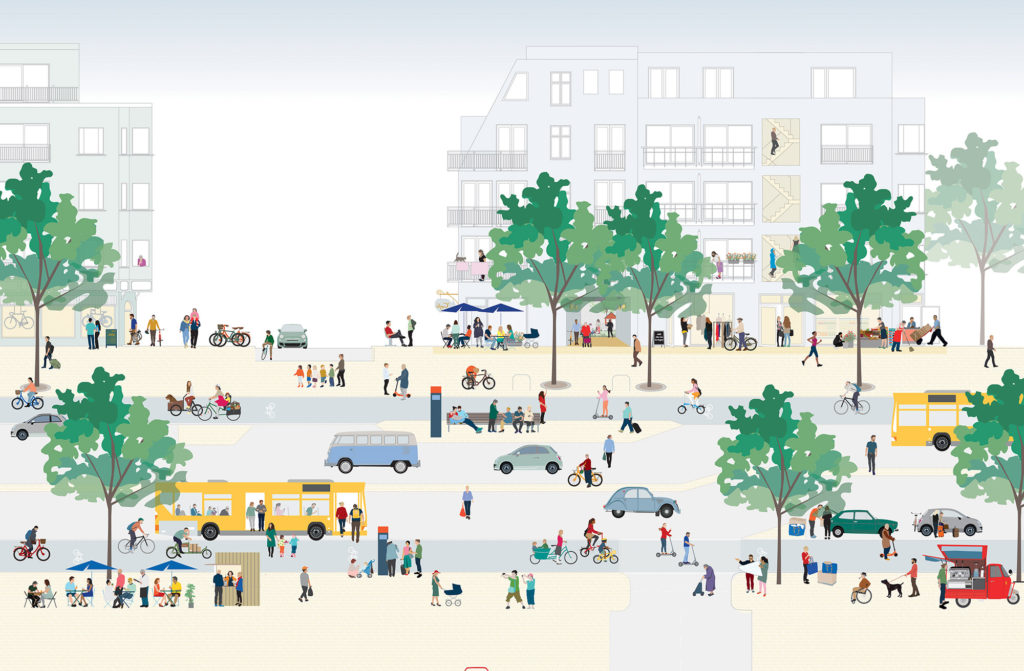Roads Reimagined
March 21, 2023
Roads occupy a staggering 18 to 30 per cent of the total available land area in cities today.1

While these figures are for American cities, similar, if not higher, percentages could be expected in other countries as well. These numbers represent a significant proportion given that space is a scarce and intensely contested urban commodity.
While roads have always been ubiquitous in the urban landscape, the 1950s saw a major shift in the impact they had on city planning. Private cars and motor vehicles, in general, began to define urban lifestyle since then. This translated to planning as cities began to be developed, and redeveloped to make way for the car. Roads took centre stage in cities and pushed the needs of its people and of Nature to the fringes.
Urban mobility is poised to undergo significant and seminal transformations yet again. While many of these changes will be necessitated by the immediate need to reduce greenhouse gas (GHG) emissions, a lot of the transformations will be enabled by innovations in technology—another pivotal transition in our lifestyles and its choices.
Car-lite cities, walkable cities, drones, hyperloops, personalised mobility devices, liveability parameters, etc., are all significant trends and measures that will be shaping the future of our cities. With such scale of changes imminent, it presents an ideal opportunity to rethink how we value our roads in this future and what purpose they could serve.
READ MORE: Travelling in the Near Future

Repurposing roads to generate clean energy
At present, road-based carbon dioxide (CO2) emissions account for 72 per cent of all transport related GHG emissions in the world—surpassing both air and sea-based transportation modes.2
In addition to emissions from vehicles, there is also the sizeable quantum of embodied emissions already spent building these roads out of high-carbon materials like cement, tar and asphalt. A study done in the UK found the whole-life emissions for a 1-kilometre stretch of road to be between 2,658.9 tonnes of carbon dioxide equivalents (tCO2e) and 880.3 tCO2e, depending on the road category.3


Soon, however, these same roads could instead be producing clean renewable energy that could power future electric vehicles (EV) as well as our cities and villages. Roads present an ideal surface for harvesting solar energy as they are often exposed and unshaded—particularly the expansive main streets and expressways, which are too wide to be shaded by tree canopies. Various stakeholders including governments, research bodies and industry players have been experimenting with this idea to produce clean energy in their countries.
Reclaiming roads as shared public spaces
Several cities across the world have been appropriating roads to return them back to the realm of the people as shared common spaces. Examples of this abound from Montreal, Philadelphia, Manhattan and Amsterdam to Milan, Barcelona, Bogotá and Singapore.

Such actions are of particular significance in high-density urban settings where public spaces have often ceded their existence to either the demands of vehicular traffic or to lucrative commercial developments. Yet, such shared spaces are vital urban elements that provide much-needed breathing space to residents. The COVID-19 pandemic further demonstrated their urgent need in cities.
[This is an excerpt. Subscribe to the digital edition or hardcopy to read the complete article.]

Alakesh Dutta is currently a Research Associate and studio tutor for the Master’s programme in Integrated Sustainable Design at the National University of Singapore (NUS) College of Design and Engineering. His current research topics include looking at a regenerative and systems-based approach to architecture and urbanism. Alakesh is also a certified architect (India) with a Master’s degree in Integrated Sustainable Design from NUS. He has extensive industry experience working in India, the US and Singapore for over 11 years. His past experiences as a Principal Architectural Associate at Surbana Jurong Consultants Pte. Ltd. included projects like the NUS SDE4 Net-Zero Energy Building; the Vertical Fish Farm for Apollo Aquaculture Group; the Jurong Innovation District by JTC; and the Connect@Changi facility at Singapore EXPO set up in response to the COVID-19 pandemic.
Related stories:
Can Pune be a Case Study for Indian Cities to Improve Pedestrian Infrastructure?

Regeneration of Disused Transport Infrastructure

The Rise of PAREX in Manila: An Antithesis to Green Mobility

Read more stories from FuturArc 1Q 2023: Mobility & Transport!

To read the complete article, get your hardcopy at our online shop/newsstands/major bookstores; subscribe to FuturArc or download the FuturArc App to read the issues.
Previously Published Commentary
Contact us at https://www.futurarc.com/contact-us for older commentaries.
